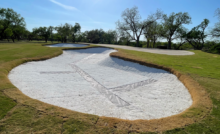Easiest Ways to Prevent Erosion: Protecting Our Environment with Simple Solutions


The golf field at luxury hotel
Erosion is a natural process that affects landscapes around the world. However, human activities often accelerate erosion, leading to severe consequences for ecosystems and communities. Thankfully, there are simple and effective methods we can implement to prevent erosion and safeguard our environment.
Easiest Ways to Prevent Erosion:
Plant Vegetation:
Vegetation plays a crucial role in preventing erosion as it stabilizes the soil, reduces surface runoff, and provides a natural barrier against the forces of wind and water. By planting native grasses, shrubs, and trees, you can significantly mitigate erosion. For example, grasses with deep root systems can anchor soil, while trees provide shade, intercept rainfall, and slow down wind speed.
Related: Are Drainage Problems Draining Your Budget… and Your Patience?
Mulching:
Mulching involves applying a layer of organic material, such as straw, wood chips, or compost, to the soil’s surface. This protective layer acts as a shield against the erosive forces of rainfall and runoff. Mulching helps retain moisture, reduce evaporation, regulate soil temperature, and enhance soil structure, making it less prone to erosion.
Terracing and Contouring:
Terracing and contouring are effective techniques, especially on sloped areas, to prevent erosion and promote water infiltration. By creating terraces or contour lines along the landscape, you can slow down the flow of water, reducing its erosive power. Terraces, which are horizontal platforms, allow water to pool and infiltrate the soil gradually. Contour lines, on the other hand, follow the natural curves of the land and help minimize the formation of runoff channels.
Retaining Walls:
Retaining walls are man-made structures built to hold soil in place, especially on steep slopes. These walls act as barriers, preventing erosion and landslides. Retaining walls can be made of various materials, including concrete, timber, stone, or gabions (wire baskets filled with rocks).
Proper Drainage:
Poor drainage can contribute to erosion by allowing excess water to accumulate and erode the soil. Installing proper drainage systems, such as French drains, gutter downspouts, and surface channels, can effectively redirect and manage water flow, reducing erosion risk.
Preventing erosion is vital for maintaining the health and stability of our environment. By implementing simple yet effective erosion control methods like planting vegetation, mulching, terracing, constructing retaining walls, and ensuring proper drainage, we can protect our lands and preserve natural resources.
About Ecological Improvements
Ecological Improvements is at the forefront of innovative erosion control solutions, specializing in Bioengineered Living shorelines. Our mission is to restore and protect aquatic environments while preserving their natural beauty. Through partnerships with environmentally conscious organizations, we actively contribute to the education, donation, and improvement of ecological health. Homeowners and businesses alike benefit from our expertise as we strive to create resilient, visually appealing, and environmentally friendly solutions for mitigating erosion. https://www.ecologicalimprovements.com/
Recent Posts
One of the Biggest Jobs in Golf
When Rory McIlroy finally slipped into the Green Jacket on Sunday, April 13, 2025, after…
Audubon International Marks Earth Day In Growth Mode
As the world celebrates Earth Day on April 22, Audubon International – the environmentally focused non-profit…
Help keep golf sustainable by bidding in GCSAA’s Rounds 4 Research online auction
In celebration of Earth Day, you can help fund the research that advances golf’s environmental…
Five Cabot Golf Courses Place in Golfweek’s Prestigious 2025 Top 100 International Courses List
Cabot, a developer and operator of luxury resort and residential golf destinations, is proud to…
Champion Hills Rebuilds with Heart: A Story of Resilience and Restoration
When Hurricane Helene swept through in late September 2024, Champion Hills Golf Club faced a…
Discover the New Graves Golf Club: A Game-Changing Facility in Edmond, OK
Graves Golf Club, the much-anticipated golf and training destination founded by celebrated instructors Tim and…


